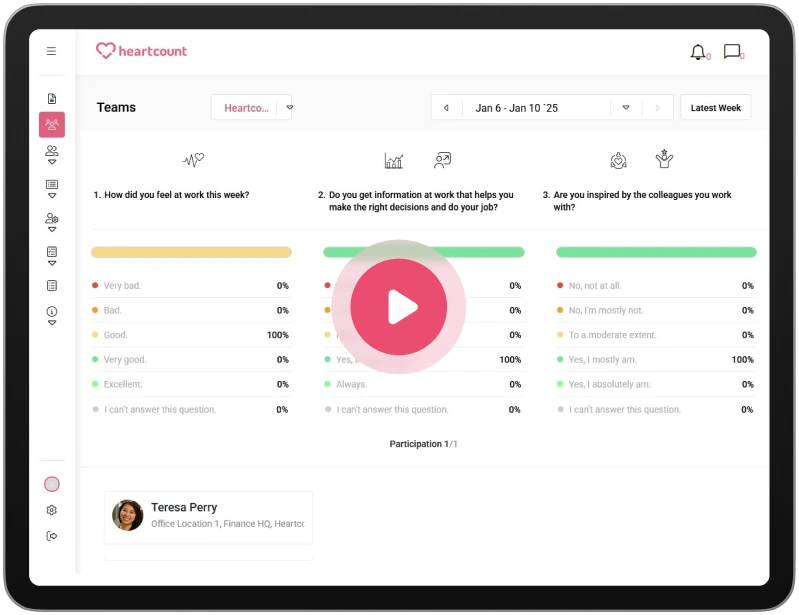360 Degree Feedback Examples (By Role, Skill & Tone) + Best Practices (2025)

Most performance feedback is one-directional. A manager evaluates, the employee listens, and the process ends. But real behavior change happens when feedback comes from multiple sources, peers, reports, and leaders, and is grounded in practical, observable input.
This is the foundation of 360 degree feedback.
It’s a structured way to gather well-rounded insights from across the org chart. When done right, it builds accountability, sharpens self-awareness, and drives development conversations that stick.
According to the Chartered Institute of Personnel and Development (CIPD), organizations that integrate multi-source feedback into their performance strategy report 30% stronger leadership pipelines and higher employee trust across functions.
This guide breaks down how to:
- Use 360 feedback effectively at scale
- See real examples for peers, managers, and execs
- Implement best practices that avoid common missteps
- Frame both positive and constructive feedback in ways that drive change
Looking for a structured way to collect insights across your teams? HeartCount gives managers real-time visibility into team sentiment with lightweight weekly pulse surveys and automatic trend detection.
-
1.What Is 360 Degree Feedback? + Sample Table
-
2.360 Feedback vs. Performance Reviews vs. Peer Reviews
-
3.Pros and Cons of 360 Degree Feedback
-
4.How to Implement 360 Degree Feedback in Your Organization
-
5.360 Degree Feedback Survey Example
-
6.360 Feedback Examples by Role and Skill
-
7.Positive & Negative 360 Feedback Examples
-
8.FAQs About 360 Degree Feedback
-
9.Conclusion: Turning Feedback into Growth
Most performance feedback is one-directional. A manager evaluates, the employee listens, and the process ends. But real behavior change happens when feedback comes from multiple sources, peers, reports, and leaders, and is grounded in practical, observable input.
This is the foundation of 360 degree feedback.
It’s a structured way to gather well-rounded insights from across the org chart. When done right, it builds accountability, sharpens self-awareness, and drives development conversations that stick.
According to the Chartered Institute of Personnel and Development (CIPD), organizations that integrate multi-source feedback into their performance strategy report 30% stronger leadership pipelines and higher employee trust across functions.
This guide breaks down how to:
- Use 360 feedback effectively at scale
- See real examples for peers, managers, and execs
- Implement best practices that avoid common missteps
- Frame both positive and constructive feedback in ways that drive change
Looking for a structured way to collect insights across your teams? HeartCount gives managers real-time visibility into team sentiment with lightweight weekly pulse surveys and automatic trend detection.
What Is 360 Degree Feedback? + Sample Table
360 degree feedback (sometimes called 360 review feedback) is a method of collecting input from multiple people around an employee, including peers, managers, direct reports, and the employee themselves.
Unlike performance reviews, which are often tied to compensation, 360 feedback is designed for development. It focuses on behaviors, not traits. And when implemented well, it opens the door for constructive conversations across levels.
Here’s a sample table of 360 degree feedback examples by role and skill. It includes both positive and constructive versions, phrased to support improvement without sounding critical.
| Role | Skill/Area | Positive Feedback Example | Constructive Feedback Example |
|---|---|---|---|
| Peer | Collaboration | “You consistently bring others into discussions and ensure everyone feels heard.” | “Sometimes your enthusiasm takes over the conversation, giving others space could make discussions more inclusive.” |
| Peer | Communication | “Your updates in team meetings are clear, concise, and easy to act on.” | “It would help the team if you provided more context when sharing updates, especially on cross-team projects.” |
| Manager | Leadership | “You set clear goals and give the team room to grow; your support is empowering.” | “More regular one-on-ones could help address issues before they escalate.” |
| Manager | Recognition | “You’re great at highlighting wins and making us feel valued.” | “It might boost morale to recognize contributions more consistently across the team.” |
| Boss/Executive | Strategic Thinking | “Your long-term vision really helps align our work with the company’s direction.” | “Sometimes the strategic goals aren’t fully communicated, more clarity would help us prioritize effectively.” |
| Boss/Executive | Approachability | “You make it easy to bring up concerns and new ideas.” | “It can be intimidating to raise issues; creating more open forums might encourage candid feedback.” |
360 Feedback vs. Performance Reviews vs. Peer Reviews
These three formats often get lumped together, but each plays a distinct role in employee development. Knowing the differences helps HR teams set the right expectations, cadence, and purpose.
| Criteria | 360 Feedback | Performance Review | Peer Review |
|---|---|---|---|
| Source of Input | Peers, managers, self, reports | Direct manager only | Co-workers only |
| Purpose | Development & insight | Evaluation & compensation | Team-based collaboration |
| Anonymity | Often anonymous | Usually transparent | Varies |
| Frequency | Continuous or periodic | Annual or bi-annual | Ad hoc or quarterly |
Bottom line: 360 degree feedback gives a broader view that’s ideal for development. Performance reviews stay focused on evaluation. Peer reviews work best when aimed at collaboration and team dynamics.
If you’re weighing whether feedback should be anonymous or confidential, see our breakdown of anonymous vs confidential surveys. It helps clarify which format fits your goals, especially in high-trust or hybrid teams.
Pros and Cons of 360 Degree Feedback
When done well, 360 feedback builds stronger teams, better leaders, and a culture of continuous improvement. But it’s not a plug-and-play solution. It requires structure, clarity, and follow-through.
Here’s a breakdown of the most relevant benefits and risks for HR and leadership teams.
Pros of 360 Degree Feedback
- Holistic input: Employees receive feedback from peers, managers, and direct reports. This reveals blind spots a single-source review would miss.
- Encourages self-awareness: When combined with self-assessment, 360 reviews help employees reflect on how others perceive their behaviors and contributions.
- Drives leadership development: Multi-source input is especially useful for assessing soft skills like communication, delegation, and decision-making. See how it aligns with our leadership development strategy.
- Improves team communication: When feedback loops are consistent, teams become more open and aligned. Peer feedback reinforces collaboration and trust.
- Data-backed decision-making: Over time, aggregated feedback helps HR spot trends across departments, job levels, or engagement scores, a core principle behind HeartCount’s pulse surveys.
Cons of 360 Degree Feedback
- Time-consuming to execute well
Without automation or templates, collecting and analyzing feedback manually takes time. It’s not sustainable without process support. - Risk of vague or biased responses
Poorly framed questions or lack of training can result in subjective, unhelpful comments. Learn how to avoid that in our feedback loop guide. - Can erode trust if mismanaged
If employees feel exposed, targeted, or ignored post-feedback, the process can do more harm than good. Anonymity must be protected, and action must follow. - Difficult to turn into action without support
Feedback on its own doesn’t improve performance. Linking it to coaching or development plans is essential, covered in more depth in our employee development blog.
How to Implement 360 Degree Feedback in Your Organization
Rolling out 360 degree feedback successfully requires more than just sending a survey. Done right, it becomes a consistent rhythm that supports growth, accountability, and retention. Here’s a step-by-step approach to get started:
1. Identify Purpose and Goals
Before launching anything, clarify why you’re collecting 360 feedback. Is it to develop leadership behaviors? Improve team dynamics? Support succession planning?
Define what success looks like, whether it’s qualitative improvement or tied to KPIs like retention or manager effectiveness scores.
2. Choose Participants Strategically
Who gives feedback matters just as much as what’s said. Include a balanced mix of:
- Managers and team leads
- Peers who regularly collaborate
- Direct reports (for leadership roles)
- External stakeholders, if relevant
- Self-assessment (always)
Ensure each group understands their role and how their feedback will be used.
3. Define Criteria and Create a Survey
Build a clear, role-relevant survey that covers both behavioral and performance areas. Include a mix of:
- Closed-ended questions for measurable data
- Open-ended questions for nuance and context
For ready-made templates, HeartCount’s custom employee survey feature lets you build and automate this quickly, including anonymity settings and report delivery.
4. Analyze Feedback
Don’t just export data. Look for themes, patterns, and red flags. Compare feedback across roles and departments to spot larger trends.
HeartCount’s analytics dashboard helps surface these insights automatically, identifying potential disengagement, manager blind spots, or cultural issues before they spread.
5. Deliver Feedback Professionally
Feedback should never arrive as a raw spreadsheet. Schedule 1:1 conversations to walk through results with context and empathy. Focus on behaviors, not personality.
If you’re not sure how to coach someone through tough feedback, this guide to giving feedback to employees is a helpful primer.
6. Link to Development Planning
Feedback without follow-up doesn’t lead to change. Turn insight into action by:
- Co-creating development goals with the employee
- Tracking progress with check-ins or coaching
- Repeating the cycle to measure improvement
Over time, this loop becomes the foundation of your culture, not a one-off HR project.
360 Degree Feedback Survey Example
The quality of your 360 review feedback depends heavily on the questions you ask. Great questions balance structure and depth. They guide reviewers to focus on observable behaviors, not vague impressions.
Below is a snapshot of well-balanced 360 degree feedback survey questions by category. These can be used as-is or adapted to suit different roles and seniority levels.
🔹 Self-Assessment
- What are your top three strengths in your current role?
- What would you like to improve or develop over the next 6 months?
- How do you think others perceive your contribution to the team?
🔹 Managerial Feedback
- How effectively does this employee prioritize tasks and meet deadlines?
- Does this employee demonstrate leadership and initiative?
- Where could they improve to increase their impact?
🔹 Peer Feedback
- How well does this person collaborate with others across functions?
- What’s one behavior that strengthens team performance?
- Is there a skill or habit this person could improve?
For more depth on peer-driven input, see our post on peer-to-peer recognition, which highlights how positive peer feedback can support culture, morale, and performance.
🔹 Direct Reports (for managers)
- Does your manager provide clear goals and expectations?
- How approachable is your manager when you face challenges?
- What would improve your experience working under this leader?
360 Feedback Examples by Role and Skill
Great 360 review feedback isn’t vague, it’s grounded in specific behaviors tied to core skills. Whether you’re evaluating a colleague, manager, or executive, your feedback should be clear, actionable, and constructive.
Below, we’ve organized sample 360 degree feedback examples by role and skill area. Each includes both positive and constructive examples to help you strike the right balance.
Peer Feedback Examples
Peers often see the everyday impact of collaboration and communication. Their input can highlight both interpersonal strengths and subtle friction points.
Collaboration
- Positive:
“You consistently bring others into discussions and ensure everyone feels heard.” - Constructive:
“Sometimes your enthusiasm takes over the conversation, giving others space could make discussions more inclusive.”
Communication
- Positive:
“Your updates in team meetings are clear, concise, and easy to act on.” - Constructive:
“It would help the team if you provided more context when sharing updates, especially on cross-team projects.”
Feedback for Managers
Managers benefit most from feedback around clarity, support, and recognition. This input often comes from direct reports and cross-functional peers.
Leadership
- Positive:
“You set clear goals and give the team room to grow, your support is empowering.” - Constructive:
“More regular one-on-ones could help address issues before they escalate.”
Recognition
- Positive:
“You’re great at highlighting wins and making us feel valued.” - Constructive:
“It might boost morale to recognize contributions more consistently across the team.”
Feedback for Executives / Bosses
When offering 360 feedback to a boss or executive, tone and delivery matter. Keep feedback focused on impact and clarity, not personality.
Strategic Thinking
- Positive:
“Your long-term vision really helps align our work with the company’s direction.” - Constructive:
“Sometimes the strategic goals aren’t fully communicated—more clarity would help us prioritize effectively.”
Approachability
- Positive:
“You make it easy to bring up concerns and new ideas.” - Constructive:
“It can be intimidating to raise issues—creating more open forums might encourage candid feedback.”
Positive & Negative 360 Feedback Examples
Strong 360 review feedback is specific, respectful, and focused on action. Vague praise doesn’t motivate, and blunt criticism without direction can damage trust. The goal is to highlight behavior and its impact, not to judge personality.
Below are examples of both positive and constructive feedback for colleagues. These can be adapted across roles and seniority levels.
Positive 360 Feedback Examples for a Colleague
These comments reinforce helpful behaviors while encouraging continued growth.
- “You consistently take initiative and follow through. Your ownership has a real impact on team momentum.”
- “You ask thoughtful questions during meetings that help clarify direction for everyone.”
- “I appreciate how you celebrate others’ wins. Your recognition helps build a strong team culture.”
If you’re looking to scale recognition within your team or department, these employee recognition templates offer a fast, practical starting point.
Negative 360 Feedback Examples (Framed Constructively)
Constructive feedback should always point toward improvement. Keep it clear, factual, and connected to observable behaviors.
- “Sometimes your feedback in meetings sounds more critical than intended. Reframing it as a suggestion could help others stay open to your input.”
- “When deadlines are missed, it affects handoffs for the team. Aligning timelines earlier would help avoid bottlenecks.”
- “You bring great energy, but occasionally interrupt others mid-point. Waiting to respond could encourage more inclusive dialogue.”
To monitor whether your team is responding to feedback over time, consider running employee pulse surveys. These provide quick, real-time insights into team sentiment and alignment.
And if you’re building a case for a more structured feedback program, understanding the ROI of employee engagement can help you connect culture initiatives with business outcomes.
FAQs About 360 Degree Feedback
What is the 360 feedback format?
It combines self-assessment, peer input, manager reviews, and sometimes direct reports. Feedback is typically collected through scaled questions and open-text comments across defined skills or behaviors.
How do you write 360 feedback for a peer?
Keep it specific and behavior-focused. Mention one clear strength and one area for growth. Use examples to support your point.
What are good 360 feedback examples?
Good examples highlight real situations, use respectful language, and offer constructive suggestions. They should guide improvement, not just critique.
How anonymous should 360 feedback be?
Ideally, feedback should be anonymous to ensure honesty, especially in peer or upward reviews. Transparency about how anonymity is protected also builds trust in the process.
Conclusion: Turning Feedback into Growth
360 degree feedback isn’t just a performance tool, it’s a culture builder. When done right, it encourages accountability, surfaces blind spots, and fuels targeted development.
But feedback alone isn’t enough. What matters is how you act on it. Teams that analyze results, close the loop, and follow up with action plans see measurable improvements in trust, morale, and performance.
If you’re aiming to make 360 review feedback part of your growth strategy, keep the process simple, respectful, and consistent. That’s what builds a real feedback culture.








